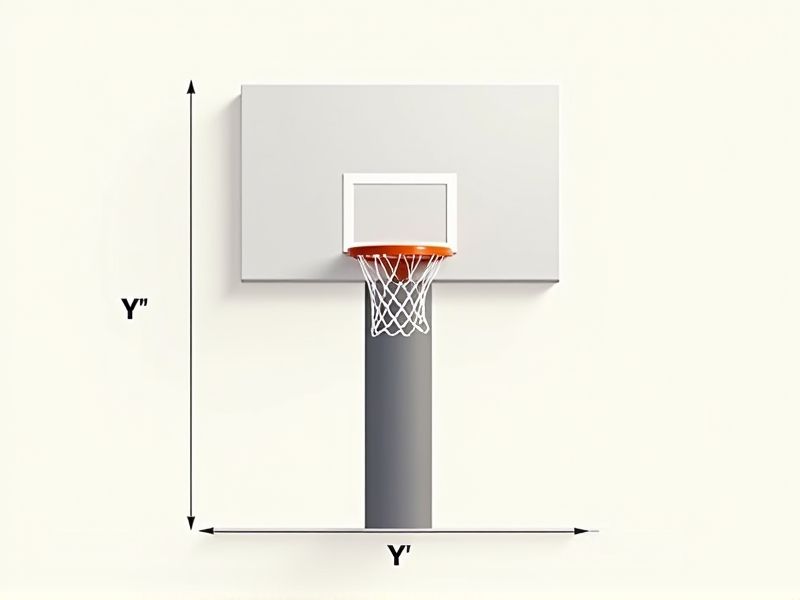
A standard basketball backboard typically measures 6 feet (72 inches) wide by 3.5 feet (42 inches) tall. These dimensions are used for both professional NBA and NCAA games, ensuring consistency across official competitions. For example, if you're installing a hoop at home and want to practice with regulation equipment, choosing a backboard with these measurements will provide the most authentic experience. Additionally, the inner rectangle on the backboard is 24 inches wide by 18 inches tall, helping players aim bank shots more effectively.
Width: 72 Inches
The standard basketball backboard measures 72 inches in width, allowing for optimal play and facilitating precise shot angles. This width is crucial for athletes to develop their skills, as it provides a consistent target during practice and competitive games. The material of the backboard typically consists of tempered glass, which offers durability and enhances the reflection of ball dynamics. By adhering to these specifications, players can experience a more professional level of play, improving your overall performance on the court.
Height: 42 Inches
The standard height of a basketball backboard is set at 42 inches for optimal gameplay. This measurement ensures proper ball reflection and accurate shooting angles during a game. When positioning your basketball hoop, maintaining this height is crucial for consistency and fairness in play. Understanding this standard can improve your shooting skills and enhance overall performance on the court.
Material: Tempered Glass
A basketball backboard made of tempered glass is designed to enhance your playing experience by offering superior rebound qualities. Tempered glass, known for its durability, is 4 to 5 times stronger than standard glass, making it resistant to impacts and weather conditions. The clear surface allows for an unobstructed view of the hoop, facilitating better shooting angles and improving overall game performance. Investing in a tempered glass backboard can significantly elevate both recreational play and competitive standards.
Thickness: 1/2 Inch
The standard basketball backboard thickness is crucial for providing durability and consistent performance during games, typically measuring 1/2 inch. This specification ensures that the backboard can withstand intense gameplay while minimizing distortion. A thickness of 1/2 inch also helps in producing a reliable rebound effect, which is essential for both offensive and defensive strategies. When selecting a backboard, consider this thickness for optimized gameplay and overall experience.
Rim Height: 10 Feet
The standard height of a basketball rim is precisely 10 feet, a measurement widely recognized across various levels of play, including high school, collegiate, and professional leagues. This uniformity ensures that players of all ages develop their skills under consistent conditions. Basketball backboards typically measure 6 feet wide and 3.5 feet tall, providing ample space for shots and rebounds. Investing in a quality backboard can enhance your practice sessions, allowing for improved shooting accuracy and overall performance on the court.
Border: 2-Inch White Rectangle
The standard basketball backboard features a regulation size of 72 inches in width and 42 inches in height, designed primarily for professional and collegiate play. The border of the backboard includes a 2-inch white rectangle, which acts as a target area for shooting. This rectangular border enhances shooting accuracy, where players aim for the square to achieve optimal angles when scoring. Understanding the precise dimensions and markings on the backboard can significantly improve your gameplay and shooting consistency.
Rim Diameter: 18 Inches
The standard basketball backboard features a rim diameter of 18 inches, which is crucial for ensuring consistent gameplay. The rim height is set at 10 feet above the playing surface, aligning with regulations established by organizations like the NBA and FIBA. Backboards are typically made of durable materials such as tempered glass, measuring 6 feet wide by 3.5 feet tall. When properly maintained, this setup facilitates precision shooting and enhances player performance on the court.
Mounting: Centered Above Key
The standard basketball backboard is typically mounted 10 feet above the playing surface, precisely centered above the key area, which measures 16 feet wide. The backboard itself spans 6 feet in width and 3.5 feet in height, providing optimal target dimensions for shooters. The hoop is positioned 18 inches inside the backboard's face and is 10 inches in diameter, ensuring standardization across regulation courts. Ensuring that your backboard is securely and accurately installed enhances gameplay quality and shooting performance.
Support Structure: Fixed Or Adjustable
The support structure of a basketball backboard can be either fixed or adjustable, influencing performance and usage. Fixed backboards typically offer greater stability, with a standard height of 10 feet, accommodating rigorous play in gyms and outdoor courts alike. In contrast, adjustable backboards provide versatility, allowing heights to range from 7.5 to 10 feet, making them ideal for players of varying ages and skill levels. Choosing the right support structure enhances your gameplay experience and ensures safety during practice or competitive matches.
Durability: Weather-Resistant
A weather-resistant basketball backboard is designed to withstand various environmental conditions, ensuring long-lasting performance. Typically made from high-density polyethylene or tempered glass, these materials enhance durability and minimize wear from rain, sun exposure, and temperature fluctuations. A quality backboard may feature a protective finish that prevents rust and fading, extending its lifespan significantly. To optimize your playing experience, look for backboards that meet or exceed industry standards, often backed by warranties of up to five years.
